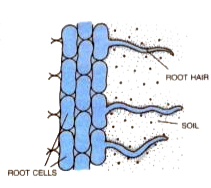The movement of water is along
1.Turgor gradient
2.DPD gradient
3.Diffusion gardient
4.Osmotic gradient
The correct Answer is:B
Step-by-Step Solution:
1. Understanding Water Movement in Plants:
Water movement in plants is essential for various physiological processes, including nutrient transport, photosynthesis, and maintaining turgor pressure.
2. Identifying the Options:
The question provides four options regarding the movement of water:
- A) Turbulent gradient
- B) DPD gradient
- C) Diffusion gradient
- D) Osmotic gradient
3. Defining DPD:
DPD stands for Diffusion Pressure Deficit. It refers to the difference in water potential between the inside of a plant cell and the surrounding solution.
4. Explaining the Concept of DPD Gradient:
When a plant cell is placed in a hypotonic solution (where the external solution has a lower solute concentration than the cell), water moves into the cell due to the DPD gradient. This movement occurs because the water potential inside the cell is higher than that in the external solution.
5. Understanding Water Movement:
The movement of water from an area of higher water potential to an area of lower water potential results in the process known as exosmosis when water moves out of the cell.
6. Conclusion:
Based on the explanation, the correct answer to the question is the DPD gradient, as it is the driving force for water movement in this context.
Final Answer: DPD Gradient (Diffusion Pressure Deficit)
---
Water movement in plants is essential for various physiological processes, including nutrient transport, photosynthesis, and maintaining turgor pressure.
The question provides four options regarding the movement of water:
- A) Turbulent gradient
- B) DPD gradient
- C) Diffusion gradient
- D) Osmotic gradient
DPD stands for Diffusion Pressure Deficit. It refers to the difference in water potential between the inside of a plant cell and the surrounding solution.
When a plant cell is placed in a hypotonic solution (where the external solution has a lower solute concentration than the cell), water moves into the cell due to the DPD gradient. This movement occurs because the water potential inside the cell is higher than that in the external solution.
The movement of water from an area of higher water potential to an area of lower water potential results in the process known as exosmosis when water moves out of the cell.
Based on the explanation, the correct answer to the question is the DPD gradient, as it is the driving force for water movement in this context.
Topper's Solved these Questions
- TRANSPORT IN PLANTSBOOK - DINESH PUBLICATION ENGLISHCHAPTER - TRANSPORT IN PLANTSEXERCISE - REVISION QUESTIONS FROM COMPETITIVE EXAMS
425 Videos
- TRANSPORT IN PLANTSBOOK - DINESH PUBLICATION ENGLISHCHAPTER - TRANSPORT IN PLANTSEXERCISE - CHECK YOUR GRASP
40 Videos
- THE LIVING WORLDBOOK - DINESH PUBLICATION ENGLISHCHAPTER - THE LIVING WORLDEXERCISE - Check your grasp
12 Videos
- VERTEBRATA-AGNATHA AND PISCESBOOK - DINESH PUBLICATION ENGLISHCHAPTER - VERTEBRATA-AGNATHA AND PISCESEXERCISE - Check Your Grasp
12 Videos
Similar Questions
Knowledge Check
Pressure on a plant cell wall caused by osmotic movement of water is called
Aosmotic pressureBwall pressureCturgor pressureDtonic pressure
Net movement of water is from
View SolutionThe movement of water and minerals in xylem and the movement of phloem sap in phloem is respectively
View SolutionIn __________ system , the movement of water is relatively slower .
View SolutionOsmosis is concerned with the movement of water only and cannot directly affect the movement of dissolved substances into the roots and through the plant.
View SolutionGiven alongside is an enlarged diagram of a part of the root. Draw arrows on the diagram to show the movement of water passing through different parts.
……………………………….
View SolutionOsmosis is the movement of water against the concentration of A and along the concentration of B. A and B are
View SolutionUpward movement of water in plants is called
View Solution